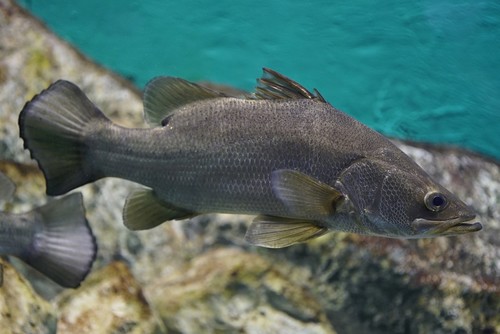
Nile Perch
The Atlantic bluefin tuna (Thunnus thynnus) is a magnificent and highly migratory species renowned for its size, speed, and commercial value. As one of the largest bony fishes, it plays a crucial role in the marine ecosystem. However, its populations have faced significant pressure from overfishing.
8 16 years
Lifespan
193 cm
Length
Least Concern
Conservation Status
60 km/h
Swimming speed
Carnivorous
Diet
Local Migration
Migration
Appearance Overview
The Atlantic bluefin tuna is a large, pelagic fish with a streamlined, torpedo-shaped body built for speed and endurance.
Color
Dark metallic blue on top with a silvery underside
Body shape
Torpedo-shaped and streamlined
Fins
Two dorsal fins, the first depressible into a groove; small finlets running down the back and belly towards the tail
Length
Up to 13 feet (4 meters), commonly around 6.5 feet (2 meters)
Weight
Up to 2,000 lbs (900 kg), commonly around 550 lbs (250 kg)
Diet
Carnivorous, feeding on a variety of fish (such as herring, mackerel, and hake), squid, and crustaceans.
Feeding Behavior
Highly active predators, bluefin tuna use their speed and agility to hunt. They often feed cooperatively, herding prey fish into tight balls before attacking.
Social Behavior
Highly migratory, forming large schools, especially during spawning season. They exhibit complex social behaviors, often associating with other tuna species.
Commercial Relevance
Extremely high value, particularly in the Japanese sushi and sashimi market, where a single fish can fetch hundreds of thousands of dollars.
Conservation measures
International fishing quotas, minimum size limits, and time-area closures are implemented. Organizations like ICCAT (International Commission for the Conservation of Atlantic Tunas) manage the species.
Status
Endangered (IUCN Red List)
Threats
Historical overfishing, which severely depleted populations, remains a significant threat. Bycatch in other fisheries and illegal fishing also pose problems.
Habitat Distribution
Depth Range
Surface waters to depths of over 3,000 feet (1,000 meters), though they typically stay in the upper part of the water column.
Geographic Range
Western and Eastern Atlantic Ocean, Mediterranean Sea, and formerly the Black Sea.
Preferred Environment
Temperate and subtropical waters; highly migratory, undertaking long trans-Atlantic migrations.
Reproduction and Life Cycle
Breeding Habits
Spawning occurs in warm waters, primarily in the Gulf of Mexico and the Mediterranean Sea. Spawning is believed to be triggered by water temperature and photoperiod.
Development Stages
Eggs hatch into larvae, which are planktonic and drift with the currents. Juveniles grow rapidly, feeding on small fish and invertebrates. They gradually develop into adults.
Fecundity
Highly fecund; females can produce up to 30 million eggs per spawning season, releasing them in batches.
Maturity Age
Reaches sexual maturity at around 4-8 years in the Mediterranean and 8-12 years in the Gulf of Mexico.
Faqs about Nile Perch
Where are Atlantic bluefin tuna found?
Atlantic bluefin tuna are found throughout the Atlantic Ocean and the Mediterranean Sea.
What is the conservation status of Atlantic bluefin tuna?
They are an endangered species due to historical overfishing.
What do Atlantic bluefin tuna eat?
They primarily eat fish, squid, and crustaceans.
How long do Atlantic Bluefin Tuna live?
Atlantic bluefin tuna can live for up to 40 years.
How many eggs can a female bluefin tuna produce?
Females can release up to 30 million eggs per spawning season.
How fast can Atlantic Bluefin Tuna Swim?
Atlantic bluefin tuna can reach swimming speeds of up to 43 mph (70 km/h).
Are Atlantic Bluefin Tuna warm-blooded?
They are warm-blooded, which allows them to maintain a higher body temperature than the surrounding water, aiding in muscle efficiency and speed.
Copyright @ Nature Style Limited. All Rights Reserved.
 English
English